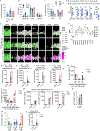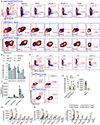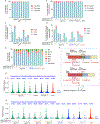Human T-bet governs the generation of a distinct subset of CD11chighCD21low B cells
- PMID: 35867801
- PMCID: PMC9413977
- DOI: 10.1126/sciimmunol.abq3277
Human T-bet governs the generation of a distinct subset of CD11chighCD21low B cells
Abstract
High-level expression of the transcription factor T-bet characterizes a phenotypically distinct murine B cell population known as "age-associated B cells" (ABCs). T-bet-deficient mice have reduced ABCs and impaired humoral immunity. We describe a patient with inherited T-bet deficiency and largely normal humoral immunity including intact somatic hypermutation, affinity maturation and memory B cell formation in vivo, and B cell differentiation into Ig-producing plasmablasts in vitro. Nevertheless, the patient exhibited skewed class switching to IgG1, IgG4, and IgE, along with reduced IgG2, both in vivo and in vitro. Moreover, T-bet was required for the in vivo and in vitro development of a distinct subset of human B cells characterized by reduced expression of CD21 and the concomitantly high expression of CD19, CD20, CD11c, FCRL5, and T-bet, a phenotype that shares many features with murine ABCs. Mechanistically, human T-bet governed CD21loCD11chi B cell differentiation by controlling the chromatin accessibility of lineage-defining genes in these cells: FAS, IL21R, SEC61B, DUSP4, DAPP1, SOX5, CD79B, and CXCR4. Thus, human T-bet is largely redundant for long-lived protective humoral immunity but is essential for the development of a distinct subset of human CD11chiCD21lo B cells.
Figures







References
-
- Szabo SJ, Kim ST, Costa GL, Zhang X, Fathman CG, Glimcher LH, A novel transcription factor, T-bet, directs Th1 lineage commitment. Cell. 100, 655–669 (2000). - PubMed
-
- Szabo SJ, Sullivan BM, Stemmann C, Satoskar AR, Sleckman BP, Glimcher LH, Distinct effects of T-bet in TH1 lineage commitment and IFN-gamma production in CD4 and CD8 T cells. Science (80-. ). 295, 338–342 (2002). - PubMed
Publication types
MeSH terms
Substances
Grants and funding
LinkOut - more resources
Full Text Sources
Research Materials
Miscellaneous

